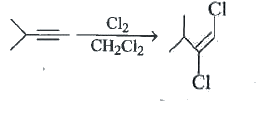In which reaction incorrect products have been reported.
The correct Answer is:C
To determine in which reaction incorrect products have been reported, let's analyze each reaction step by step.
Step 1: Analyze the First Reaction
Reaction: CH2=CHOH + HCl
1. Protonation: The double bond attacks the H+ from HCl, leading to the formation of a carbocation.
2. Intermediate Formation: The carbocation is CH2+CH(OH).
3. Nucleophilic Attack: Cl- attacks the carbocation, resulting in CH2Cl-CH(OH).
4. Rearrangement: The product rearranges to form CH2Cl-CH2-C(=OH) (alcohol).
Conclusion: The product is correct.
Step 2: Analyze the Second Reaction
Reaction: CH2=CHC(=OH) + H2O
1. Nucleophilic Attack: Water attacks the double bond, leading to the formation of an alcohol.
2. Intermediate Formation: The intermediate is CH2(OH)-CH(OH)-C(=OH).
3. Rearrangement: The product rearranges to form CH2(OH)-CH2-C(=OH).
Conclusion: The product is correct.
Step 3: Analyze the Third Reaction
Reaction: CH3-CH=CH-CH(=OH)-CH3
1. Protonation: The double bond is protonated, forming a carbocation.
2. Intermediate Formation: The carbocation is CH3-CH+-CH(OH)-CH3.
3. Nucleophilic Attack: Methanol attacks the carbocation, leading to CH3-CO-CH3-CH(OH).
4. Rearrangement: The product rearranges, but here the structure does not lead to a stable product.
Conclusion: The product is incorrect.
Step 4: Analyze the Fourth Reaction
Reaction: CH3-CH2-CH(OH)-CH3
1. Carbocation Formation: The hydroxyl group stabilizes the carbocation.
2. Nucleophilic Attack: The methanol attacks the carbocation, leading to CH3-CH2-CH(OH)-CH3.
3. Final Product: The product formed is stable.
Conclusion: The product is correct.
Final Conclusion
The incorrect product is from the third reaction (option C).
---
Reaction: CH2=CHOH + HCl
2. Intermediate Formation: The carbocation is CH2+CH(OH).
3. Nucleophilic Attack: Cl- attacks the carbocation, resulting in CH2Cl-CH(OH).
4. Rearrangement: The product rearranges to form CH2Cl-CH2-C(=OH) (alcohol).
Reaction: CH2=CHC(=OH) + H2O
2. Intermediate Formation: The intermediate is CH2(OH)-CH(OH)-C(=OH).
3. Rearrangement: The product rearranges to form CH2(OH)-CH2-C(=OH).
Reaction: CH3-CH=CH-CH(=OH)-CH3
2. Intermediate Formation: The carbocation is CH3-CH+-CH(OH)-CH3.
3. Nucleophilic Attack: Methanol attacks the carbocation, leading to CH3-CO-CH3-CH(OH).
4. Rearrangement: The product rearranges, but here the structure does not lead to a stable product.
Reaction: CH3-CH2-CH(OH)-CH3
2. Nucleophilic Attack: The methanol attacks the carbocation, leading to CH3-CH2-CH(OH)-CH3.
3. Final Product: The product formed is stable.
The incorrect product is from the third reaction (option C).
Topper's Solved these Questions
- BOOK - RESONANCE ENGLISHCHAPTER - ORGANIC REACTION MECHANISMS - IIEXERCISE - APSP Part - 242videos
ORGANIC REACTION MECHANISMS - II
- BOOK - RESONANCE ENGLISHCHAPTER - MOLE CONCEPTEXERCISE - ORGANIC CHEMISTRY(BASIC CONCEPTS)27videos
MOLE CONCEPT
- BOOK - RESONANCE ENGLISHCHAPTER - ORGANIC REACTION MECHANISMS-IVEXERCISE - APSP PART-322videos
ORGANIC REACTION MECHANISMS-IV
Similar Questions
Knowledge Check
- Question 1 - Select One
In which of reactions final product is NOT a ketone :
A B
B C
C D
D
- Question 2 - Select One
Which reaction yields the major product shown?
A B
B C
C D
D
- Question 3 - Select One
Reaction in which one of the products is water.
Aprecipitation reactionBdecomposition reactionCneutralizaion reactionDsingle displacement reaction
The reaction with incorrect major product is -
View SolutionIn which reaction the product is not correctly given ?
View SolutionWhich chemical reaction contains incorrect products?
View SolutionHow many species of orchids has been reported ?
View SolutionWhich of the following reaction correctly reports the major product?
View Solution

